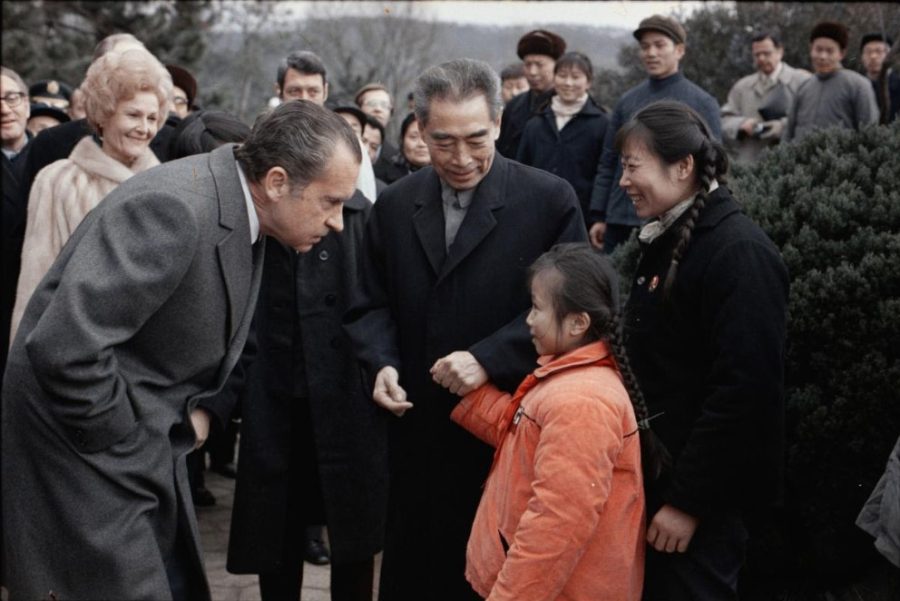U.S., China continue problematic relationship
President Richard Nixon and Chinese Premier Chou En-Lai greet a young girl Feb. 26, 1972, at Hang Chou West Lake Park during the president’s historic visit.
March 22, 2023
It is no secret that America has always had a rocky relationship with China. But since the beginning of this year, this relationship has only seen more tension.
The relations between the US and China started to settle in 1953, after both nations signed the Armistice Agreement as a way to put an end to the Korean War. But it was not until 1971 that the relationships started to warm up. It was in April of that year that China’s ping-pong players invited members of the US team to their country. This trip was the first time since 1949 that Americans were allowed into China.
The next year, President Nixon visited China in order to sign the Shanghai Communique. This was supposed to set the stage for improving the relationship between the two nations by allowing them to discuss difficult issues. These were the first steps that the two countries took to try and form an alliance.
President Carter took the next step in this alliance by giving China full diplomatic recognition. However, in April of that year, Congress approved an act that allowed America and Taiwan to continue commercial and cultural relationships. This caused tensions to once again rise between the countries.
As the years went on, the relationship was still tense. In 2000, President Clinton signed the US-China Relations Act. This guaranteed normal trade between America and Beijing. Due to this, China became the US’s second-biggest trading partner.
It was in 2007 that China started to increase military spending, and the US realized that there may be other ulterior motives since the country’s claim of having a “peaceful rise” was not consistent with what they were doing. And in 2012, tensions in the trade started to rise. When China exported rare earth metals, the US claimed that China had broken international trade laws.
China acquired a new leader in 2012, which resulted in Xi Jinping replacing Li Keqiang as premier. Jinping aimed to “rejuvenate” China. The next year, President Obama hosted Jinping in the US and used this as an opportunity to establish new relationships after years of tension.

(White House Press Office)
In 2014, the tensions started to rise again. In May of that year, the US believed that five Chinese hackers were behind major online breaches. 2015 brought a new string of issues. Starting in May, the US first started to warn China about the South China Sea, and the American government believes they first started setting up military equipment there.
During Trump’s presidency, he tried to settle the issues. First, he agreed to the One-China Policy and thought that, although it angered many in the US, it did help improve the relationship between the two nations. He then hosted Jinping at Mar-a-Lago to “deepen the understanding” the two had of one another.
But like all good things, even this relationship must come to an end. In 2018, the trade war escalated as the US put more tariffs on Chinese goods. Thus causing China to retaliate with its own tariffs on American goods.
The war only got more intense in 2019, as the Trump administration raised tariffs from 10 to 25 percent on goods. This was in order to try and force China to make a deal favorable to the US. But in the following year, the first steps were taken to diminish this trade war.
As the pandemic arose, nations everywhere, including the US, turned their blame onto China. This caused not only the government to have a tense relationship with China, but also the US citizens.
Between designating China’s abuse of Uyghurs as genocide, maintaining high tariffs, and allegedly helping Russia in the war with Ukraine, tensions are higher than ever.
Now a Chinese-operated balloon has flown over the U.S. in the past month. Many government officials are convinced that this was a spy balloon, but China maintains their original statement claiming that it was a weather-monitoring balloon. But this had the US so suspicious that a trip to visit China was canceled to protect the US representative.
Will China and the U.S. ever have a solid relationship or will the nations always be on the rocks? It’s hard to tell now, but looking at the history, it would seem that will never occur. For now, they seem to be locked in a stalemate.





